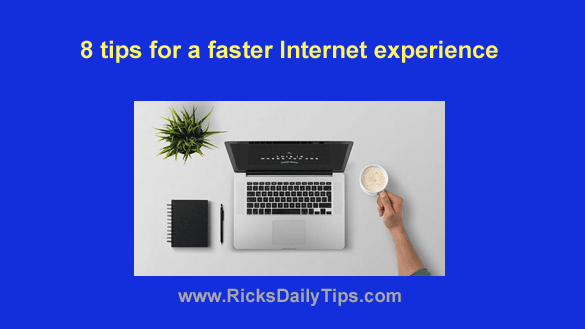
Want to get my easy to follow Tech Tips in your email?
Sign up for my daily Rick’s Tech Tips Newsletter!
Note: The links in this post are affiliate links.
If you’re like most people, you probably wish you had a faster Internet connection.
After all, it’s never fun having to wait for what seems like an eternity while your favorite website loads or a download completes.
Regardless of the speed promised for the Internet Service Plan you are subscribed to, chances are your Internet experience could be enhanced at least somewhat by making a few tweaks and changes. Here are just a few to get you started:
1 – Make sure your PC is completely free of malware. One of the most common causes of sluggish system performance and Internet slowdowns/hangups are malware infections. Follow the directions in this post to find and eradicate any viruses, trojans, spyware or adware that might be on your PC’s hard drive.
2 – Make sure your router is capable of supporting the maximum connection speeds provided with your Internet Service Plan. Some older routers were built using out-of-date technology that simply cannot keep up with modern download speeds.
If your router is an older “N” or “AC” class router I recommend that you consider getting a super-fast and super-secure AX class router so you can take full advantage of the latest Internet standards and security methods.
If you decide to stay with your current router make sure it has the latest firmware installed. Keeping your router’s firmware up-to-date will ensure that it can handle your Internet traffic as smoothly and quickly as possible.
You can check to see if there’s a firmware update available for your router by plugging its model number into the Support section the manufacturer’s website. If an update is available, follow the directions on the download page to install it.
3 – Make sure your computer’s Ethernet card and/or Wi-Fi card is fast enough to support the maximum speeds of both your Internet connection and router. If not, you can install either an inexpensive USB Wi-FI Adapter or a USB Gigabit Ethernet Adapter
to bring your system’s network capabilities up to speed.
4 – Try several different web browsers to see which browser loads your most-visited websites the fastest.
Simply changing the browser you use can make a big difference in how quickly your favorite sites will load because some browsers handle different Internet technologies more efficiently than others.
Here is a short list of the most popular web browsers along with links to their download pages:
- Google Chrome
- Microsoft Edge (Edge is already installed for Windows 10 users)
- Firefox
- Brave
- Opera
5 – Periodically clear your web browser’s cache. Corrupted files stored in the browser cache can cause problems ranging from sluggish browser performance to hanging websites to overall system instability.
You’ll find a button or link somewhere in your browser’s Settings for clearing the cache.
Alternatively, you can use the simple method explained in this post to quickly clear your browser cache with a key combination and a click or two.
Important: Clearing your browser’s cookies could result in you being logged out of some or all of the websites/services that you are currently logged into. Make sure you know (or have access to) all of your passwords before clearing browser cookies!
6 – Use the awesome Fing mobile app to make sure your neighbors aren’t piggybacking on your Wi-Fi connection. The more devices that are sharing your router’s Wi-Fi network, the slower connection speeds YOU will experience.
For example, someone using your Wi-Fi connection to watch videos on Netflix or play online games will slow your own connection speed to a proverbial snail’s pace!
In fact, even just having them use your Wi-Fi network to surf the web or check their email will have an impact on your overall connection speeds. And if they’re using your Internet connection to do things that are illegal it could easily end up landing YOU in trouble with the law.
You can easily make sure that no one can log into your Wi-Fi network by enabling the strongest encryption method that your router supports and then choosing a password that is secure, yet easy to remember.
7 – After you have taken care of items 1-6 you should visit Speedtest.net to check your Internet connection’s actual download and upload speeds. If the maximum speeds returned by the test are pretty close to the speeds promised for your Internet Service Plan, you’re in good shape.
However, if the speeds returned by the test are well under what you should be getting, I recommend calling your Internet Service Provider and asking them to find out why you aren’t getting the speeds you have been promised.
Chances are a bad connection to their backbone cable and/or a bad, outdated or poorly configured modem is limiting your connection speeds. If so, they’ll need to fix whatever is causing the problem so you can start getting the speeds you are paying for.
8 – If everything mentioned above seems to be as they should be, that means your only option for speeding up your Internet connection is to move up to a faster Internet plan.
That could be as simple as upgrading your plan to a higher service “tier” with your current ISP or as complicated as switching providers altogether (for example, moving from Satellite Internet or DSL to Cable).
Bottom line: There’s no reason why you should have to put up with a sluggish Internet experience given the state of today’s technology. The steps listed above can help ensure that you’re getting the speeds you’re paying for (and hopefully the speeds you want).